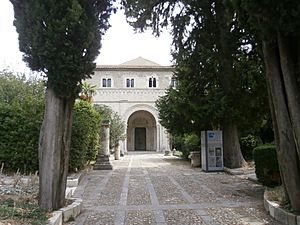John Clement Gordon facts for kids
John Clement Gordon (born 1644, died 1726) was an important Scottish church leader. He was known as the Bishop of Galloway. He came from the Gordon family in a place called Coldwells, near Ellon in Aberdeenshire, Scotland.
Contents
His Life Story
Becoming a Bishop
John Gordon started his career as a chaplain in the Royal Navy. A chaplain is a minister or priest who serves in the military. Later, he became a royal chaplain in New York, America. By this time, he had earned a special degree called a Doctor of Theology.
In 1687, there was an opening for the Bishop of Galloway. A special permission document, called a congé d'élire, was issued for him. This meant he was allowed to be chosen for the role. He was officially elected bishop on February 4, 1688. He was then consecrated, which means formally made a bishop, in Glasgow by John Paterson, who was the Archbishop of Glasgow.
Life After the Glorious Revolution
After an important event called the "Glorious Revolution" in 1688, John Gordon followed King James VII/II to Ireland and then to France. While living in a place called Saint-Germain, he would read the church service for English, Scottish, and Irish Protestants who visited him.
However, later on, he changed his religion. He became a Roman Catholic. This happened after he met a famous French bishop named Jacques-Bénigne Bossuet. It seems he secretly joined the Roman Catholic Church while in France. Later, he publicly announced his change of faith in Rome. He did this in front of a high-ranking church official called Cardinal Giuseppe Sacripanti.
New Name and Role
When John Gordon had a special "conditional baptism" in the Roman Catholic Church, he took an extra name. He chose the name of the Pope at that time, who was Pope Clement XI. From then on, he signed his name as "John Clement Gordon."
The Pope wanted to give John Clement Gordon some financial support. So, he asked the church's special court, called the Inquisition, to check if Gordon's previous Anglican orders were valid. After a long check, the church decided that his Anglican orders were not valid from the start. This decision was made on April 17, 1704.
After this, John Clement Gordon received another church sacrament called confirmation. Pope Clement XI then gave him the tonsure, which is a special haircut for clergy. The Pope also gave him the income from the Abbey of San Clemente a Casauria. Because of this, John Clement Gordon was often called the "Abate Clemente." It's interesting to note that he only received minor roles in the Roman Catholic Church, not higher ones.
Later Years and Legacy
John Clement Gordon passed away in Rome in 1726. He was living in the Papal States when King James VIII/III (who was also a claimant to the British throne) moved his court there in 1717.
Some people thought he wrote a debated book called Pax Vobis, or Gospel Liberty. However, it is now believed he was not the author. John Clement Gordon was the last Bishop of Galloway in the official Church of Scotland. This is because the role of bishops was removed from the Scottish Church in 1689. However, bishops of Galloway continued to exist in the Episcopal Church of Scotland. This church was not allowed by the government at the time, but for people who supported the old royal family (called Jacobites), it was seen as the true continuation of the ancient church.


